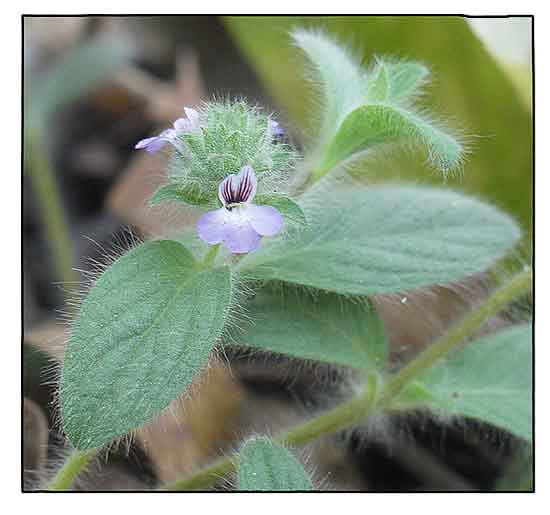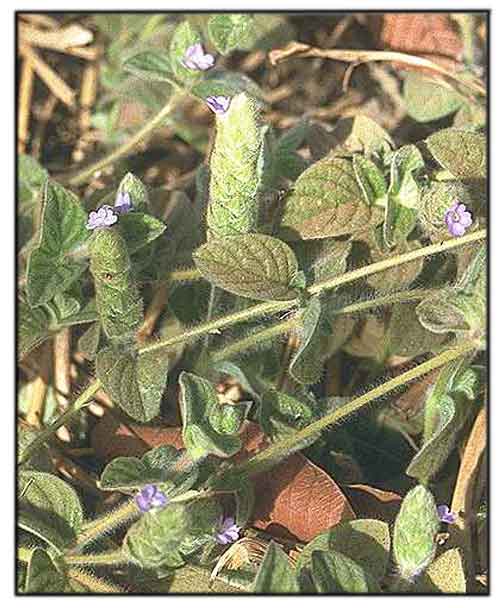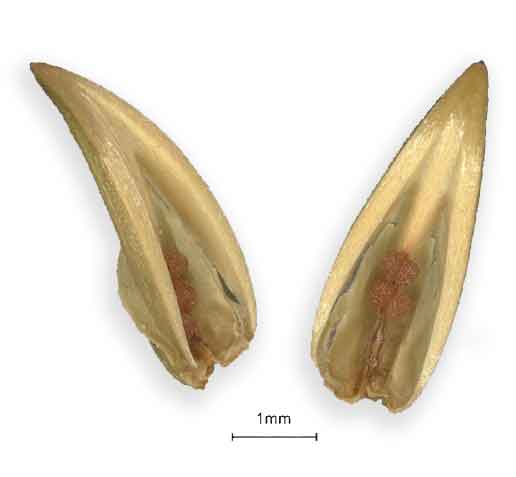Gen info
- Nelsonia canescens is a herbaceous plant species in the family Acanthaceae, with a substantial number of similar plant specimens now identified as synonyms. (13)
-
Etymology: The species epithet "canescens" refers to the leaves which are canescent i.e., covered in white, thin hairs.
 Botany Botany
Growth form: Herbaceous perennial with trailing or erect growth habit. Habitat: Occurs in savanna grasslands. Found in shady locations near streams or between rocks that become submerged after heavy rainfall. Stems: Stems are thickly covered in soft, long hairs. Foliage: Opposite, sessile leaves are elliptic with entire leaf margin. They are deeply veined and densely covered in long, soft hairs. Flowers: White or bluish to purplish flowers are bilabiate with a small, bi-lobed upper lip and a large, tri-lobed lower lip. White flowers are uniformly white, while purple flowers have an upper lip streaked with dark purple lines. Flowers are arranged in spike inflorescences and occur between leaf-like bracts that are ovate and hairy. Fruits: Dry, dehiscent fruits are known as capsules. They are oblong and pointed at the tips. (Flora & Fauna Web)
• Nelsonia canescens is a prostrate species of which only the spike like inflorescences are erected. The leaves are simple and opposite. They are very large and long petiolate at the base of the plant, on the other hand they are short, subsessile and woolly on the flowering branches. The flowers, protected by the bracts of the spike, are blue. The fruit is a dehiscent capsule containing many seeds. (WIKTROP) (11)
Distribution
- Native to the
Philippines. (1)
- Also native to
Andaman Is., Angola, Assam, Bangladesh, Benin, Botswana, Burkina, Burundi, Cambodia, Cameroon, Caprivi Strip, Central African Republic, Chad, China South-Central, China Southeast, Congo, East Himalaya, Equatorial Guinea, Eritrea, Ethiopia, Gabon, Gambia, Ghana, Guinea, Guinea-Bissau, Gulf of Guinea Is., India, Ivory Coast, Kenya, Laos, Liberia, Madagascar, Malawi, Malaya, Mali, Mauritania, Mozambique, Myanmar, Nepal, New Guinea, Nicobar Is., Niger, Nigeria, Northern Territory, Queensland, Rwanda, Senegal, Sierra Leone, Sudan, Sulawesi, Tanzania, Thailand, Uganda, Vietnam, West Himalaya, Western Australia, Zambia, Zaïre, Zimbabwe. (1)
- Widely distributed in all tropical regions. A common weed of intensified annual crops with high fertilizer inputs and mechanical tillage. It is common in vegetable crops where it can be abundant if not controlled by repeated weeding.
(11)
 Constituents Constituents
- Phytochemical screening of N. canescens plant powder yielded saponins, tannins, flavonoids, terpenoids, cardiac glycosides, carbohydrates, and proteins, with absence of alkaloids and steroids. (see study below) (9)
- Study of N. canescens extracts polyphenol profile revealed five phenol acids (p-coumaric, caffeic acid, chlorogenic acid, ferulic acid, and gentisic acid) and three flavonoids (apigenin, luteolin, quercetin).
(see study below) (10)
- Phytochemical screening of aqueous leaves extract revealed presence of alkaloid, total phenol, flavonoids, saponins, and tannins at concentrations of 330.00, 144.60, 107.04, 72.50, 42.17 mg/g respectively. (see study below) (16)
Properties
- Studies have suggested antidiabetic, anti-inflammatory, analgesic, hypolipidemic, anticancer, anti-acetylcholinesterase, hepatoprotective, antioxidant, anthelmintic, antibacterial, hemolysis inhibitory, immune boosting, hepatoprotective,
anti-stress properties.
Parts used
- Roots, leaves, sap.
Uses
Edibility
- No studies or reports found on edibility.
 Folkloric Folkloric
- No reported folkloric medicinal use in the Philippines.
- In Odisha, India, roots used for pain and inflammation.
- In Guinea, plant is known as a salt substitute. Sap of leaves applied to guineaworm sores in the Ivory coast-Upper Volta to kill causative parasites. Nupe of northern Nigeria use brew of the plant for treating small pox. In Taganyika, sap is taken for diarrhea and root decoction used for schistosomiasis. (15)
- In India, leaf paste applied topically for chest pain.
Others
- Agroforestry / Weed control: Study showed potential as non-leguminous cover crop for weed control in banana plantations. (see study below) (14)
- Fodder: In Nigeria, plant is used as fodder for goats and sheep.
- Aquarium plant: Some use in Australia as an aquarium plant.
Studies
• Antidiabetic / Hypolipidemic: Study evaluated the antidiabetic activity of aqueous extract of Nelsonia canescens and partitioned fractions in alloxan-induced diabetic male albino rats. Extract doses of 50 and 300 mg/kbw was used. Glibenclamide was used as standard. Results showed dose-dependent hypoglycemia effect with significant reduction (p<0.05) of blood glucose: ethyl acetate > aqueous extract > methanol fraction. A significant difference (p<0.05) was seen in lipid profiles and serum enzyme activities of rats. Results showed the aqueous extract and fractions showed hypoglycemic and hypolipidemic potential and significantly (p<0.05) reduced progression of oxidative stress. (4)
• Analgesic / Anti-Inflammatory / Leaves: Study evaluated an ethanolic extract of dried leaves of Nelsonia canescens for anti-inflammatory and analgesic activities in rat. Extract doses of 50-200 mg/kg significantly (p<0.05) inhibited carrageenan-induced paw edema and cotton pellet granuloma. Same doses showed analgesic activity in hot plate latency assay and early and late phase of formalin-induced paw licking in rats. Results justify traditional used of the plant for treating pain. (5)
• Hepatoprotective / Paracetamol-Induced Toxicity: Study evaluated a methanol extract (MLE) of N. canescens plant at doses of 150, 300, and 500mg/kbw against paracetamol induced acute hepatic damage. Results showed hepatoprotective potency in a dose dependent manner. The 500 mg/kg dose showed significant effect, comparable to protective effect of standard drug Silymarin (100 mg/kbw). Phytoconstituents flavanoids and phenolics may have contributed to the hepatoprotection. (6)
• Anti-Inflammatory / Roots: Study evaluated the acute and chronic anti-inflammatory activity of root powder of Nelsonia canescens in Wistar albino rats, using models of carrageenan-induced paw edema, formaldehyde-induced hind paw edema, and common pellet-induced granuloma formation. Both doses of 270 mg and 540 mg/kg showed significant anti-inflammatory activity against chronic inflammation. Results suggest the root of N. canescens has effect on sub-acute inflammation and mild to moderate effect against acute inflammation. (7)
• Cytotoxicity Potential Against Cancer Cell Lines: Study evaluated the potential cytotoxicity and selectivity of different extracts of N. canescens on human cervical cancer HeLa and SiHa cells lines. By MTT assay, a methanol extract showed higher cytotoxic activity in a dose-dependent manner against both HeLa and SiHa cells with IC50s of 21.72 and 25.30 µg/mL respectively. ME showed best selectivity index value of 7.93 with the HeLa cell line, while the EAE showed best selectivity index value of 7.48 with SiHa. Results suggest potential for exploitation in cervical cancer treatment. (8)
• Anthelmintic / Leaves: Study evaluated the anthelmintic properties of ethanol extracts and fractions of N. canescens leaves pm adult earthworms, Pheretima posthuma. Phytochemical analysis yielded presence of flavonoids, saponins, and tannins. Proximate analysis revealed moisture content of 7.3% and ash value of 19.5%. Plant was nontoxic with LD50 of ≥ 5000 mg/kg. At dose of 50 mg/ml, the crude extract and EA fractions showed significant (p<0.01) paralysis and extremely significant mean time of death (p<0.01). (9)
• Anti-Acetylcholinesterase / Antioxidant: Study evaluated the anti-acetylcholinesterase and antioxidant activities and major polyphenolic compounds of N.canescens extracts. A butanol extract exhibited best anti-acetylcholinesterase activity with % inhibition of 55.62%. The ethyl acetate extract showed best ABTS radical cation scavenging capacity with 56.20 mg equivalent trolox/g while crude extract showed highest inhibition of rat liver lipid peroxidation (2.57%. All extracts exhibited antioxidant and AChE inhibition capacities. (10)
• Use as Non-Leguminous Cover Crop: Study evaluated the effect of Nelsonia canescens on banana yield parameters, snails population and weed species diversity and abundance and its potential as a covercrop in weed management in banana plantations. Results showed reduced abundance and vigor. Reduction in abundance ranges from 60 to 100%, more pronounced during dry season when cover crop was dense. Number of snails was also significantly reduced. N. canescens also showed advantage of being prostrate and does not climb on banana pseudostems. Study suggests good alternative weed management tool in banana production. (14)
• Antimicrobial / Leaves: Study evaluated the phytochemical constituents and antimicrobial activity of aqueous extracts of leaves of Nelsonia canescens. The extract showed highest mean zone of inhibition of 20.05 mm at 20 mg/ml with MIC at 1.25 mg/ml and MBC of 10 mg/ml. For Staphylococcus aureus, mean ZOI was 18.00 at 20 mg/ml with MIC of 1.25 and MBC of 5.0 mg/ml. Crude extract also showed activity against Gram(-) Pseudomonas aeruginosa, Escherichia coli and Salmonella typhi and Gram(+) Staphylococcus aureus and Streptococcus pyogenes. (see constituents above) (16)
• Immune Boosting / Leaves: Study evaluated the effects of aqueous leaf extract of plant on osmotic fragility of rat's red blood cells, and hematological and serum chemistry changes from oral extract doses of 200. 400. and 800 mg/kg for 28 days. Results showed concentration dependent inhibition of hypotonic solution induced rat erythrocyte hemolysis comparable to indomethacin. Hematologic analysis showed significant increase (p<0.05) in total WBC and lymphocytes in groups administered 400 and 800 mg/kg extract while neutrophils decreased significantly. Results suggest anti-inflammatory activity and inhibition of RBC hemolysis. Increase in WBC and lymphocytes, which supports used of plant as immune booster by traditionalists. (17)
• Acute Toxicity Study: Acute toxicity study of aqueous leaf extract of Nelsonia canescens revealed an oral LD50 >2000 mg/kbw in mice. Phytochemical screening yielded alkaloids, phenols, tannins, flavonoids, and saponins. The phytoconstituents and LD50 values may explain the traditional use of the plant for a wide range of illnesses such as fever, pain, chicken pox, measles constipation, and gastric ulcer without reports of unwanted effects. (18)
• Antidiabetic / Antioxidant / Leaves: Study evaluated invitro antioxidant and invivo antidiabetic activity of chloroform fractions of N. canescens leaves in male Wister rats. Hyperglycemia was induced intraperitoneally by alloxan monohyrdate injection. Chloroform fractions doses of 50, 150 and 300 mg/kbw were used, with glibenclamide as standard. The fraction exhibited antioxidant activity in a concentration dependent manner with % inhibition of 68.20% at 100 µg/mL against DPPH radicals compared with ascorbic acid (89.28%). At 300 mg/kbw, blood glucose was reduced along with lowered total cholesterol, LDL-cholesterol, and triglycerides with increased HDL-cholesterol. There was significant increase in catalase, superoxide dismutase and reduced glutathione activities. Results showed the chloroform fraction of N. canescens possess significant antioxidant and antidiabetic activities. (19)
• Hepatoprotective / Carbon Tetrachloride Toxicity: Study evaluated the invivo protective effect of Nelsonia canescens extracts against CCl4-induced hepatotoxicity in rats. A methanol extract exhibited good antihepatotoxicity. Pretreatment with the ME and silymarin decreased the level of lipid peroxidation with resulting decrease of malondialdehyde. Serum alanine aminotransferase level of extract treated batch (20.93) was close to silymarin control batch (17.77 IU/L). Tissue healing effectiveness was similar with N. canescens extract and silymarin. Results supports the wide used of the plant species in Burkina Faso traditional medicine for liver disorders. (20)
• Analgesic / Roots: Study evaluated the analgesic activity of root of Nelsonia canescens using doses of 270 and 540 mg/kg in albino rats, using formalin induced paw licking and tail flick methods, and indomethacin and pentazocine as standard analgesic drugs. Both dose levels decreased paw licking response at both time intervals. In tail flick method, the test drug increased pain threshold in a dose dependent manner. Results suggested the root possesses moderate analgesic activity. (21)
• Anti-Stress Activity: Study evaluated the effect of aqueous extract of N. canescens on behavioral and neurochemical characteristics using the chronic restrained stress model. Restraint stress was used to induced female reproductive and behavioral dysfunction in rats. Results zhowed increase in entries and open arm time exploration in Elevate Plus Maze, a significant decrease in corticosterone and prolactin levels in extract treated rats, along with significantly increased levels of serotonin, triglyceride, adrenaline, cholesterol, FSH, LH, and glucose. The extract showed protective effect on stress induced reproductive and behavioral changes. The anti-stress activity may be due to alkaloids and flavonoid constituents. (22)
Availability
- Wild-crafted.
|

![]()






